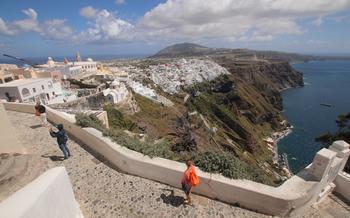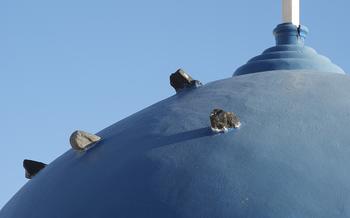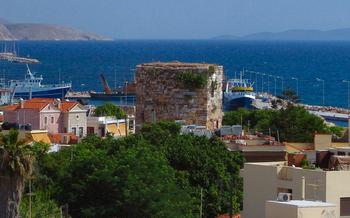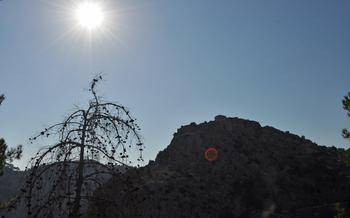
The Salt Museum of Kalloni
- The Salt Museum of Kalloni: A Unique Experience
- A Journey Through Time: Historical Significance
- The Process Unveiled: Salt Production Techniques
- Behind the Scenes: Meet the Salt Workers
- A Sensory Delight: Tasting the Salt of Kalloni
- Beyond the Museum: Exploring Kalloni Town
- Natural Wonders: Exploring the Kalloni Salt Flats
- The Salt Road: A Cultural and Historical Trail
- Salt Festivals and Events: Celebrating Kalloni's Heritage
- Sustainable Tourism: Responsible Exploration
- Photography Opportunities: Capturing the Beauty of Kalloni
- Local Cuisine: Savoring the Flavors of Kalloni
- Accommodation Options: Finding Your Home Away from Home
- Transportation: Getting Around Kalloni and Beyond
- Insider Tip: Hidden Gems and Off-the-Beaten-Path Experiences
The Salt Museum of Kalloni: A Unique Experience
The Salt Museum of Kalloni, located on the beautiful island of Lesvos in Greece, offers a unique and immersive experience for visitors interested in the history, culture, and traditions of salt production. The museum showcases the rich heritage of salt-making in the region, which has played a vital role in the development of Kalloni and the surrounding area.
Established in 1995, the Salt Museum aims to preserve and promote the traditional techniques and practices of salt production that have been passed down through generations. Visitors to the museum can learn about the history of salt production in Kalloni, dating back to ancient times, and its significance to the local economy and culture. The museum also highlights the challenges and complexities involved in salt production, as well as the dedication and expertise of the salt workers who have kept this tradition alive.
The museum's collection includes a variety of artifacts, tools, and equipment used in the salt-making process, providing visitors with a glimpse into the daily lives and work of the salt workers. Interactive exhibits and multimedia presentations further enhance the visitor experience, making it a truly immersive and educational journey through the history of salt production in Kalloni.
A Journey Through Time: Historical Significance
The Salt Museum of Kalloni is not just a museum; it is a journey through time, a voyage into the rich historical tapestry of salt production in Kalloni. Salt has been an integral part of Kalloni's identity for centuries, shaping its culture, economy, and way of life.
In ancient times, Kalloni was renowned for its salt production, and the salt flats were a source of wealth and prosperity for the region. The salt trade flourished, and Kalloni became a hub of maritime activity, connecting with other regions and cultures across the Mediterranean Sea.
The museum delves into this fascinating history, showcasing artifacts, tools, and documents that tell the story of salt production in Kalloni from ancient times to the present day. Visitors can learn about the techniques and methods used by salt workers over the centuries and gain insights into the challenges and triumphs they faced.
The museum also highlights the impact of salt production on the local culture and economy. Salt was not just a commodity; it was a way of life for the people of Kalloni. The salt flats provided employment and sustenance, and the salt trade brought prosperity to the region.
Through interactive exhibits and multimedia presentations, the museum brings the history of salt production in Kalloni to life, offering visitors a truly immersive and educational experience.
The Process Unveiled: Salt Production Techniques
The salt-making process in Kalloni has been passed down from generation to generation, preserving traditional methods that have stood the test of time. It begins with the collection of seawater from the nearby Kalloni Gulf, which is then transferred to shallow evaporation ponds. As the sun's heat evaporates the water, the salt concentration increases, forming a brine solution.
The brine is then directed into a series of smaller ponds, where further evaporation takes place. The salt crystals gradually form and are collected by salt workers using traditional tools, such as wooden rakes and baskets. The crystals are then transported to drying areas, where they are spread out to remove any remaining moisture.
Once the salt is completely dry, it is ready for packaging and distribution. Kalloni salt is renowned for its high quality and distinct flavor, making it a prized ingredient in both local and international cuisine. The traditional methods employed in its production ensure that the salt retains its natural minerals and trace elements, contributing to its unique taste and properties.
Behind the Scenes: Meet the Salt Workers
The beating heart of the Salt Museum of Kalloni is the salt workers, whose lives and experiences are intricately intertwined with the history and traditions of salt production. These dedicated individuals, often from generations of salt-making families, possess a wealth of knowledge and expertise that they readily share with visitors.
Meet Mr. Giorgos, a veteran salt worker with over 40 years of experience. With a deep sense of pride, he demonstrates the traditional salt-making techniques, explaining each step with patience and passion. He recounts tales of his early days, when he would work alongside his father, learning the intricacies of the trade.
Mrs. Maria, another skilled salt worker, shares her insights into the challenges of modern-day salt production. She describes the impact of climate change on salt yields, the fluctuating market prices, and the competition from industrial salt producers. Yet, despite these challenges, her love for the craft and her commitment to preserving traditional methods shine through.
Through their stories and demonstrations, these salt workers provide a glimpse into the rich cultural heritage of Kalloni. Their dedication ensures that the ancient art of salt production continues to thrive, captivating visitors with its authenticity and resilience.
A Sensory Delight: Tasting the Salt of Kalloni
The salt produced in Kalloni is renowned for its distinct flavor and characteristics. It possesses a delicate yet complex taste, with a subtle sweetness and a hint of bitterness. The unique flavor profile is attributed to the natural minerals and trace elements present in the seawater, which are concentrated during the evaporation process.
Kalloni salt is a versatile ingredient that enhances the flavor of various dishes. It is commonly used in traditional Greek cuisine, particularly in seafood dishes, where it brings out the natural sweetness of the fish or shellfish. It is also used in meat dishes, vegetables, and salads, adding a subtle depth of flavor.
Visitors to Kalloni can purchase the salt directly from the museum shop or from local markets and shops. It is available in various forms, including fine salt, coarse salt, and sea salt flakes. You can also find a variety of salt-based products, such as flavored salts, salt scrubs, and bath salts.
To truly experience the culinary delights of Kalloni salt, be sure to visit the local restaurants and cafes. Many establishments incorporate the salt into their dishes, creating unique and flavorful experiences. From traditional Greek dishes to modern fusion cuisine, you will find that Kalloni salt adds a touch of magic to every meal.
Beyond the Museum: Exploring Kalloni Town
Beyond the captivating Salt Museum, Kalloni Town beckons visitors to delve deeper into its rich cultural heritage and vibrant ambiance. The town's charm unfolds as you stroll through its narrow cobbled streets, where history whispers in every corner.
One of Kalloni's must-see attractions is the imposing Castle of Kalloni, a testament to the town's strategic importance throughout history. Perched atop a hill, the castle offers breathtaking panoramic views of the town, the salt flats, and the Aegean Sea. Explore its ramparts, towers, and dungeons, and let your imagination transport you back to a time of knights and battles.
Kalloni's markets and shops are a treasure trove of local crafts, souvenirs, and culinary delights. Browse the stalls and discover handmade pottery, woven textiles, and traditional sweets that reflect the town's unique identity. Indulge in the flavors of Kalloni at its tavernas and cafes, where you can savor fresh seafood, succulent lamb dishes, and the town's signature dish, "Kalloni loukoumades" – mouthwatering doughnuts drenched in honey syrup.
Throughout the year, Kalloni hosts a variety of events and festivals that celebrate the town's culture and heritage. Don't miss the annual Salt Festival, where you can witness traditional salt-making demonstrations, taste local delicacies, and immerse yourself in the lively atmosphere. Other events include the Kalloni Carnival, with its colorful parades and festivities, and the Kalloni Wine Festival, where you can sample local wines and enjoy live music.
Natural Wonders: Exploring the Kalloni Salt Flats
The Kalloni salt flats, spanning over 10,000 acres, are a breathtaking natural wonder that offers a unique and tranquil escape. Immerse yourself in the serene beauty of this vast expanse, where the shimmering white salt crystals create a mesmerizing landscape that stretches as far as the eye can see. The tranquility of the salt flats is palpable, inviting you to slow down, relax, and connect with the natural world.
The salt flats are home to a diverse array of wildlife, including over 200 species of birds. Observe the graceful flight of flamingos, egrets, and herons as they soar above the flats in search of food. The salt flats also provide a sanctuary for a variety of other animals, such as foxes, hares, and reptiles, which thrive in this unique ecosystem.
For nature enthusiasts, the Kalloni salt flats offer a wealth of activities to enjoy. Embark on a leisurely walk or bike ride along the designated trails, taking in the stunning views and the tranquility of the surroundings. Birdwatching enthusiasts can bring their binoculars and cameras to capture the beauty of the diverse birdlife. Photography lovers will find endless opportunities to capture the ethereal beauty of the salt flats, especially during sunrise and sunset when the colors of the sky reflect on the salt crystals, creating a magical spectacle.
Remember to practice responsible exploration and conservation when visiting the salt flats. Stay on designated trails to avoid disturbing the wildlife and the delicate ecosystem. Respect the natural beauty of the area by refraining from littering or causing any damage to the environment. By embracing sustainable practices, you can help preserve this unique natural wonder for generations to come.
The Salt Road: A Cultural and Historical Trail
The Salt Road is an ancient trade route that connected the salt flats of Kalloni to the rest of the world. It was used for centuries to transport salt from Kalloni to other parts of Greece and beyond. The route of the Salt Road is still visible today, and it is a popular destination for hikers, cyclists, and history buffs.
Along the Salt Road, you will find a number of historical sites and attractions, including ancient ruins, medieval castles, and traditional villages. The road also passes through some of the most beautiful scenery in Greece, including the Kalloni Salt Flats, the olive groves of Lesvos, and the Aegean Sea.
There are a number of ways to experience the Salt Road. You can hike or cycle the entire route, or you can choose to visit individual sections. There are also a number of organized tours and day trips that offer transportation and guided tours of the Salt Road.
No matter how you choose to experience it, the Salt Road is a fascinating and rewarding journey. It is a chance to learn about the history and culture of Kalloni, to see some of the most beautiful scenery in Greece, and to experience the authentic side of the region.
Salt Festivals and Events: Celebrating Kalloni's Heritage
Kalloni's rich salt-making heritage is celebrated through a variety of festivals and events held throughout the year. These events offer a unique opportunity for visitors to immerse themselves in the town's culture and traditions while enjoying a range of activities and attractions.
One of the most popular events is the Annual Salt Festival, held in August. This vibrant festival showcases the town's salt-making traditions with live demonstrations, workshops, and exhibitions. Visitors can learn about the history and techniques of salt production, sample local dishes featuring Kalloni salt, and enjoy live music and dancing.
Another highlight is the Kalloni Salt Flats Birdwatching Festival, held in October. This event attracts bird enthusiasts from around the world, as the salt flats are home to a diverse array of migratory birds. Visitors can participate in guided birdwatching tours, workshops, and seminars, and witness the spectacular spectacle of thousands of birds taking flight.
These festivals and events not only celebrate Kalloni's salt-making heritage but also contribute to the town's economy and promote sustainable tourism. By attending these events, visitors can support local businesses, learn about the importance of salt production, and experience the unique culture and traditions of Kalloni.
Sustainable Tourism: Responsible Exploration
Sustainable tourism is an essential aspect of preserving Kalloni's unique salt-making traditions and protecting its natural environment. Visitors can contribute to sustainability by choosing eco-friendly accommodation options, reducing their carbon footprint through responsible transportation choices, and supporting local businesses that prioritize sustainability.
Minimizing environmental impact involves simple actions like conserving water and energy, recycling and reducing waste, and respecting the natural beauty of the region. Visitors should also be mindful of their interactions with the local community, respecting cultural norms and traditions.
Initiatives and organizations in Kalloni are dedicated to promoting sustainable tourism. The Kalloni Salt Flats Nature Reserve is a protected area that provides a haven for wildlife and offers opportunities for sustainable exploration. The Kalloni Salt Museum also plays a crucial role in educating visitors about the importance of sustainable salt production and its impact on the local environment.
By embracing sustainable practices, visitors can help ensure that Kalloni's salt-making heritage and natural beauty are preserved for future generations to appreciate.
Photography Opportunities: Capturing the Beauty of Kalloni
Kalloni and its surroundings offer a wealth of photographic opportunities for enthusiasts of all skill levels. The vast salt flats, with their intricate patterns and shifting colors, are a photographer's paradise. Capture the sunrise or sunset over the flats for breathtaking shots. The Salt Museum of Kalloni itself is a picturesque subject, with its traditional architecture and exhibits of salt-making tools. Explore the town of Kalloni to find charming streets, colorful buildings, and lively markets that offer candid moments and street photography opportunities.
For bird lovers, the Kalloni Salt Flats are a haven for diverse bird species. Photograph the elegant flamingos, graceful egrets, and other migratory birds that frequent the area. With a telephoto lens, you can capture close-ups of these beautiful creatures in their natural habitat. The surrounding countryside also offers stunning landscapes, rolling hills, and picturesque villages that are perfect for capturing the essence of rural Greece.
Remember to respect the privacy of the locals and ask permission before taking photos of people. Share your stunning shots of Kalloni on social media using hashtags like #Kalloni, #SaltFlats, and #Greece to inspire others to explore this hidden gem. Your photos can help promote Kalloni's beauty and attract more visitors to this unique destination.
Local Cuisine: Savoring the Flavors of Kalloni
Kalloni's cuisine is a delightful blend of traditional Greek flavors and unique ingredients influenced by the town's rich history and salt-making traditions. Here, you'll find dishes that showcase the versatility and deliciousness of Kalloni salt.
One must-try dish is the "almira," a traditional Greek salad made with fresh, locally grown tomatoes, cucumbers, onions, and feta cheese, all seasoned with a generous sprinkle of Kalloni salt. The salt enhances the natural flavors of the vegetables and adds a subtle depth to the dish.
Another popular dish is "garides me halva," succulent shrimp cooked in a creamy sauce made with Kalloni salt and ouzo, a traditional Greek anise-flavored spirit. The salt adds a savory note to the sauce, while the ouzo imparts a hint of sweetness and anise flavor.
For a taste of Kalloni's unique culinary heritage, try "avgotaraho," a delicacy made from salted and cured fish roe. This dish is often served as an appetizer or meze, and its salty, briny flavor is sure to tantalize your taste buds.
To experience the full range of Kalloni's culinary delights, be sure to visit local restaurants and tavernas that specialize in traditional Greek cuisine. Many of these establishments offer cooking classes and workshops where you can learn to prepare authentic Kalloni dishes using fresh, local ingredients.
Whether you're indulging in a traditional Greek salad, savoring the flavors of "garides me halva," or trying the unique delicacy of "avgotaraho," Kalloni's cuisine is sure to leave you with a lasting impression.
Accommodation Options: Finding Your Home Away from Home
Kalloni offers a diverse range of accommodation options to suit every budget and preference. From cozy guesthouses and traditional tavernas to modern hotels and luxury resorts, there's something for every traveler. For a budget-friendly stay, consider the family-run Hotel Kalloni, which offers basic but comfortable rooms with stunning views of the salt flats. If you're looking for a bit more luxury, the Kalloni Bay Hotel & Spa is a great choice, with its elegant rooms, private balconies, and a rooftop pool overlooking the Aegean Sea. For a truly unique experience, book a stay at the Salt Flats Lodge, a charming hotel built on stilts amidst the salt flats, offering unparalleled views and a truly immersive experience.
When choosing your accommodation, consider your budget, travel style, and the location you prefer. If you're on a tight budget, guesthouses and hostels offer a great value for money. If you're looking for a more comfortable stay, opt for a mid-range hotel or a traditional taverna. For a luxurious getaway, splurge on a stay at one of the high-end resorts with private pools and spas.
To ensure a hassle-free stay, it's advisable to book your accommodation in advance, especially during the peak season. Many hotels and guesthouses offer online booking facilities, making it easy to secure your reservation. If you're traveling during the off-season, you may be able to find last-minute deals or discounts.
Transportation: Getting Around Kalloni and Beyond
Kalloni is a well-connected town, and getting around is a breeze. Public transportation options include buses and taxis, which provide convenient and affordable ways to explore the town and its surroundings. For those who prefer the freedom and flexibility of traveling at their own pace, renting a car or bicycle is a great option. Numerous rental agencies in Kalloni offer a variety of vehicles to choose from, allowing you to explore the island at your leisure.
If you're interested in venturing beyond Kalloni, organized tours and day trips are available that offer transportation to nearby attractions and villages. These tours provide a hassle-free way to explore the region's rich history and culture, often accompanied by knowledgeable guides who can share insights and stories about the area.
Navigating Kalloni's local transportation system is straightforward. Buses run on regular schedules and connect the town with nearby villages and points of interest. Taxi stands are conveniently located throughout Kalloni, and fares are generally reasonable. When renting a car, be sure to have a valid driver's license and be prepared for narrow roads and limited parking in some areas.
To truly immerse yourself in the local culture, consider exploring Kalloni on foot or by bicycle. The town is relatively compact, and many attractions are within walking distance. Biking is a popular way to explore the surrounding countryside, offering a chance to discover hidden gems and enjoy the beautiful scenery.
Whether you choose to navigate Kalloni by public transportation, rental car, bicycle, or on foot, you'll find that getting around the town and its surroundings is easy and convenient. Embrace the flexibility of exploring at your own pace, and don't hesitate to ask for directions or recommendations from friendly locals.
Insider Tip: Hidden Gems and Off-the-Beaten-Path Experiences
Beyond the popular attractions and tourist hotspots, Kalloni offers a treasure trove of hidden gems and off-the-beaten-path experiences waiting to be discovered. Venture into the narrow cobblestone streets of the old town to uncover charming cafes, artisan workshops, and hidden courtyards. Explore the surrounding countryside to find secluded beaches, picturesque villages, and traditional tavernas serving authentic local cuisine.
One hidden gem worth seeking out is the small church of Agios Nikolaos, nestled on a hilltop overlooking the town. This 12th-century Byzantine church offers stunning views of the surrounding landscape and a glimpse into the region's rich religious heritage.
For an off-the-beaten-path experience, head to the nearby village of Skala Kallonis, known for its traditional boat-building yards. Here, you can witness the skilled craftsmanship of local boat builders as they create wooden fishing boats using techniques passed down through generations.
To truly immerse yourself in the local culture, join one of the many cooking classes or workshops offered in Kalloni. Learn to prepare traditional dishes using fresh, locally sourced ingredients and discover the secrets of Kalloni's unique culinary heritage.
Getting off the beaten path in Kalloni is all about embracing the unexpected and exploring with an open mind. Whether you're seeking hidden historical gems, tranquil natural landscapes, or authentic cultural experiences, Kalloni offers a wealth of opportunities to discover its lesser-known treasures.






